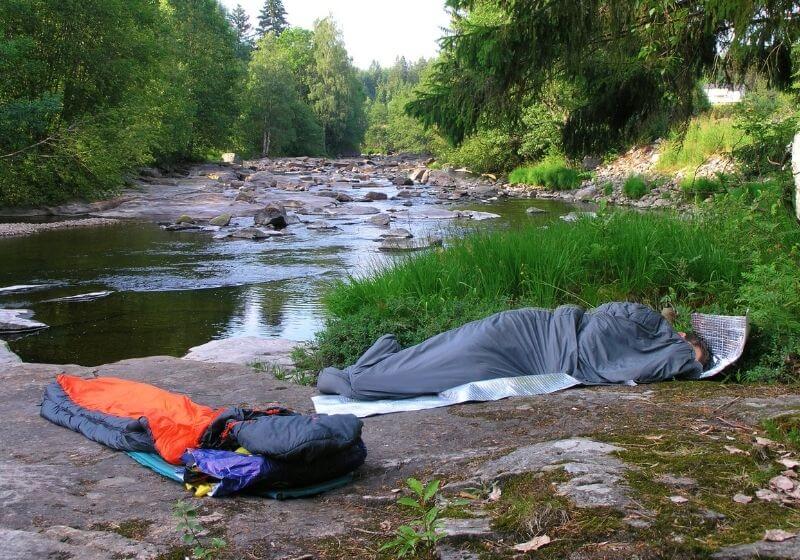Camping
Ultimate Bivy Sack Sleeping Guide [Infographics]
Published
4 years agoon
![Sleeping bag between two dead trees | Ultimate Bivy Sack Sleeping Guide [Infographics] | Featured](https://outdoorwarrior.com/wp-content/uploads/2021/03/Sleeping-bag-between-two-dead-trees-Bivy-sack-Featured-SS-.jpg)
Using a bivy sack is a great way to keep your backpack light while getting close to nature during your overnight outdoor trips.
Here is a detailed guide to sleeping in bivy bags.
In this article:
- Tips on Choosing the Perfect Bivy Sack
- Do’s When Using A Bivy Sack
- How to Use a Bivy Sack
- Who Can Use a Bivy Sack
- Why Should Adventure Seekers Consider Having Bivy Sacks
- What Are the Disadvantages of Using Bivy Bags
RELATED: Ultimate Backpacking Checklist for Beginners
Everything You Need to Know About Sleeping in a Bivy Sack | Infographic
— This post is courtesy of the Survival Life shared with permission —
Click here to jump to the infographic.
Tips on Choosing the Perfect Bivy Sack

Even with tons of bivouac models in the market, there are a few that cut across all brands and are vital:
- Design: Bivouac’s features should match your needs. Remember to consider ventilation options during purchase. Bivouacs with a mesh panel around the head allow you to leave the Goretex hood off during fair weather.
Other designs include a hooped tent pole to help keep the head panel away from your face. - Lightweight: Since the goal of choosing bivouacs is to cut down on the weight, ensure you choose one whose weight is ideal. Weight under 500 grams is always the best.
- Good fit: Though most models come in one-size-fits-all, check beforehand that the dimensions will suit you without compromising comfort. Also, allowing some extra room for storage is a great idea.
- Great quality: Since the biggest problem with bivy bags is condensation, consider one made with a breathable material such as E-vent or Goretex regardless of your expected weather.
Do’s When Using A Bivy Sack
- Check the weather forecast.
- Find a sheltered area.
- Scan your surroundings to ensure safety
- Settle down far away from where you cooked your meals
- Make sure your clothes are dry before going inside the sack.
- Do not cover your face completely.
- Bring heat packs, especially during cold seasons.
- Consider taking a lightweight tarp with you if it’s snowing.
- Turn your bivy sack inside out during the day.
- Invest in a backpack liner for your gears.
How to Use a Bivy Sack?

Using bivy bags correctly is the first step towards enjoying the experience. Here are some pointers:
- Setting up: Like with tents, choose flat ground that is unlikely to flood, is safe, not in the path of animals and humans, and free of any sharp or harmful objects. It should also be away from fire or avalanche zones during winter.
- Sleeping mat: We lose most of our body heat through the ground, hence why you need a sleeping mat. Go for a brand with straps to keep the mat in place when you turn in your sleep.
- Turning during sleep: Bivy bags tend to roll when not trapped in. To avoid this, turn the upper half of your body and then the lower. However, consider installing some elastic straps.
- Packing your bivouac: Depending on how much space you have inside the sack, you can consider stuffing some of your belonging around you. Otherwise, leave it in your backpack and set it inside a large pack liner to protect it from rain. Stuffing foodstuff in the sack is a good idea.
- Condensation: To deal with moisture, leave the headcover off and use the mesh unless it rains. Even then, leave a small opening to allow air circulation.
- Sleeping on snow: Ensure your chose spot is safe and away from avalanche paths and trees. Keep in mind that due to the low temperature, moisture in the sack freezes at night, making it less breathable.
RELATED: Camping Gear Checklist For The True Outdoor Warriors
Who Can Use a Bivy Sack?

Usually, adventure seekers use bivy sacks when they plan on spending a night or two outdoors, especially when a bivy sack is more convenient than a tent.
However, a bivy sack should be an emergency backup for one spending time outdoors even when they do not plan to stay outdoors overnight. Mountaineers mostly do this, but all other outdoor enthusiasts should join the bandwagon.
Why Should Adventure Seekers Consider Having Bivy Sacks?

Like with most things, bivy sacks come with a fair of advantages:
- Weight: This is the biggest advantage that bivy bags have over tents. Most bivy bags weigh between 300and 400 grams which is less than the lightest one-person tent. Carrying a lighter backpack when adventure-seeking equates to more fun.
- Space: Due to their lightweight, bivy sacks take up little room both in your backpack and on the ground. Therefore, you will need far less space to set up than you would with a tent. This means you get to set up in cool spots where a tent wouldn’t otherwise fit.
- Warmth: Compared to tents, bivouacs are more compact. The reduced air space means faster heat transmission hence warming up faster than a tent would.
- Ease-to-use: Bivouacs don’t have poles or guy lines which means you can set them up in no time. The applies to packing them away. This makes them perfect for campers who want fewer chores and more time to explore.
What Are the Disadvantages of Using Bivy Bags?

Firstly, bivouacs can be uncomfortable, especially for people who are not used to them. Also, some models lack a way to keep the head panel off someone’s face, which can be uncomfortable even for recurrent bivy bag users.
Secondly, they lack enough internal space to store your belonging which is never an issue with tents. Knowing how to deal with this beforehand will save you the stress.
Lastly, they are not as waterproof as tents and can therefore be uncomfortable in rainy weather. During such times, condensation is bound to be another cause of alarm.
Here’s an infographic guide to sleeping in a bivy sack. Don’t forget to download, save, or share this handy infographic for reference:

Want to see the full article?
Click here to read the full article on Survival Life.
There you have it, preppers. Bivy sacks are the new normal if you are going on solo missions or don’t want the burden and the work that comes with carrying a tent. Keep these pointers in mind when purchasing and using one, and you will be set for a night in the outdoors.
Have you used a bivy sack before? What tips would you like to share? Let us know in the comment section below!
Up Next:
- How to Choose The Right Backpacking And Trekking Tents
- Bring These Camping Appliances With You Every Trip
- Big Wild Hog Hunting In Texas
Don’t forget to stay connected with us on Facebook, Twitter, Pinterest, and Instagram!
TIME SENSITIVE INFORMATION: EX-CIA Agent Takes You Through The Intensive Sharp Shooter Training He Learned In The CIA Academy. In Just 30 Days Learn To Be A Sharp Shooter Like Every Agent Leaving The Academy.
Disclaimer: All content on this site is for informational purposes only. Please read our full disclaimer here.
You may like

How To Build A Debris Hut

Ironman Triathlon Podcast: What You Need To Know As An Aspiring Ironman

Awesome Family Camping Tips For Beginners

Hiking Safety Tips: What To Do When You Have Knee Pain On Trail? [PODCAST]

How To Craft Sharp Stone Tools To Survive The Great Outdoors

Mountain Bikers, Why You Don’t Want to Ride Like a Pro!

Hiking Boot Accessories
The Handgun Safety Test For Beginners
These Hunting Shotguns Are The Best Bang For Your Buck
11 Types of Guns That Will Keep You Alive On Doomsday
Best ATV Tires – The Top 6 Lightest Mud Tires

The Top 5 Hunting Guns You’ll Ever Need For A Wilderness Walk-out
Arizona Hunting Laws and Regulations

Hunting And Conservation Discussion | Call Of The Outdoors Podcast [LISTEN]
The Handgun Safety Test For Beginners
These Hunting Shotguns Are The Best Bang For Your Buck
11 Types of Guns That Will Keep You Alive On Doomsday
Best ATV Tires – The Top 6 Lightest Mud Tires

The Top 5 Hunting Guns You’ll Ever Need For A Wilderness Walk-out
Arizona Hunting Laws and Regulations






